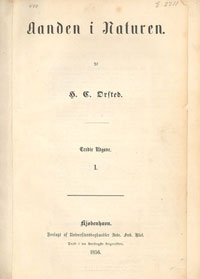Art, Culture and Science does not exclude religion
Ørsted knew several of the great Danish artists personally. Already as students the two Oersted brothers became friends with the poet and author Adam Oehlenschläger.
Oersted also had opinions about society and religion. For example, in 1814 he was involved in a long controversy with the poet and theologian N.F.S. Grundtvig, about religious beliefs.

This debate started because Grundtvig wrote in an article that science is the enemy of Christianity. The three young people spent a great deal of time discussing science, art and philosophy. They had strong opinions about everything and confident that each of them would go far in life.
The battle for the free press
And in the 1830s when there arose a debate about the freedom of press, Ørsted threw himself into the fray and became the head of the Free Press Society. Hans Christian Ørsted's brother Anders Sandøe Ørsted was forced to stop writing his social criticism articles because he was a high ranking official. However, the two brothers continued to discus and share their opinions with each other as always and Hans Christian now wrote on behalf of both of them.
For Ørsted it was always about being guided by reason and in that way one gets closer to truth. Both science and free debate allowed, in his view, for truth to come to light.

Reserve Family of H. C. Andersen
But Ørsted was also interested in culture from a purely aesthetic perspective. When the young H.C. Andersen arrived in Copenhagen, Ørsted was an established professor. Ørsted invited Andersen to dinners in his home and praised his writing talent.
Gradually, Ørsted's family became a kind of extra family for the poet and according to Andersen himself, the old Ørsted was the man he had loved the most. Andersen was also very influenced by Ørsted's ideas, and added two additional chapters to his book "In Sweden", which was directly inspired by Ørsted's concept of nature.
In many ways Ørsted also considered himself more as a humanist than as a scientist. His papers were sometimes mixed up with small poems or more thoughtful descriptions of how he had gotten the idea for the experiment. Ørsted used a very poetic language even though he was writing about research.
 The Spirit in Nature
The Spirit in Nature
In 1849 Ørsted published a more philosophical book: "The Spirit in Nature". Just as he had done since his youth he makes the argument that natural research is an important part of the youth education. Partly because it trains young people to distinguish between true and false and partly because the naturalist describes the eternal laws of nature, which the artist subsequently expresses.
So it is also for the sake of the artist that the sciences have a separate place in universities.
|
|

